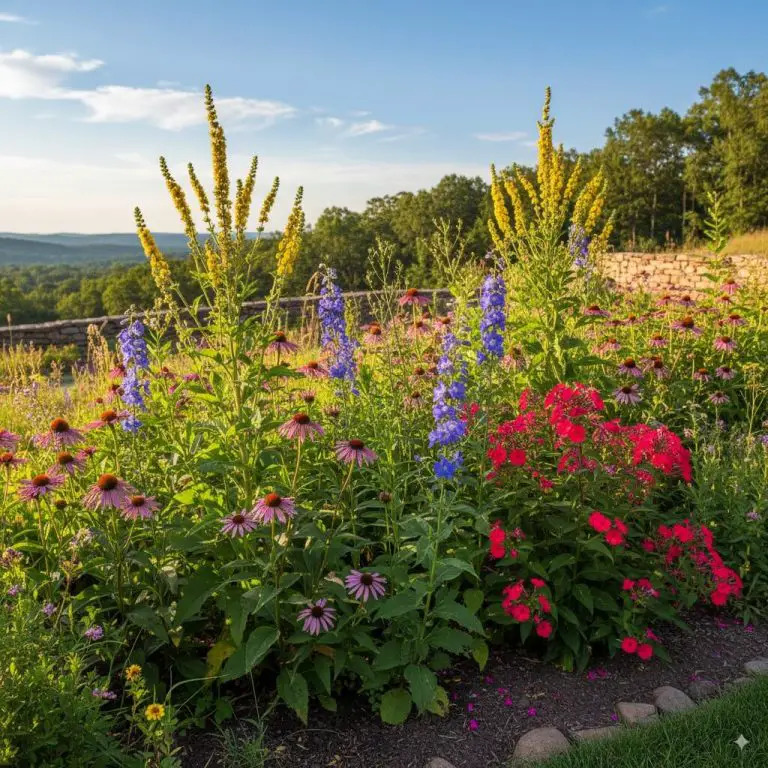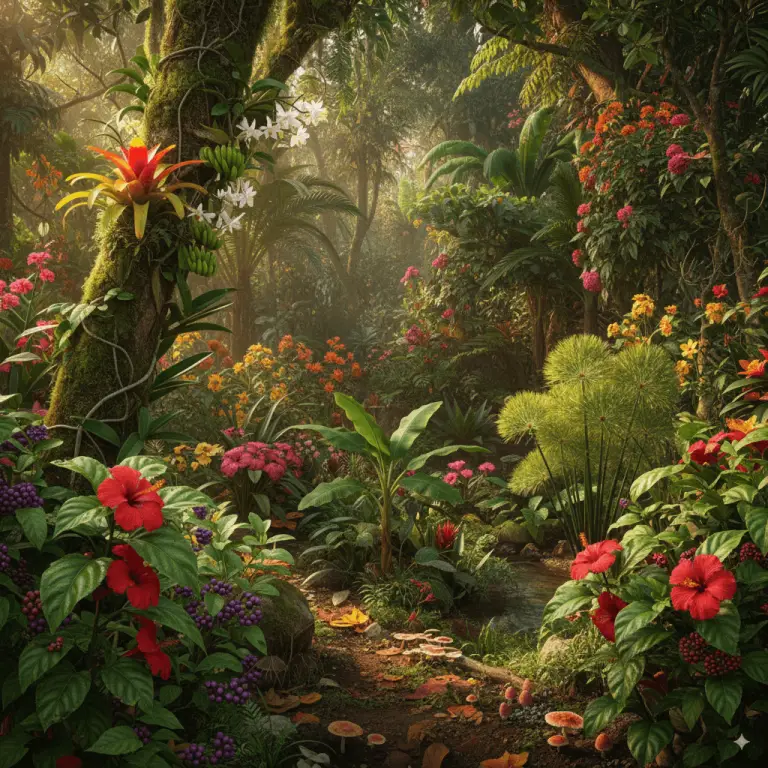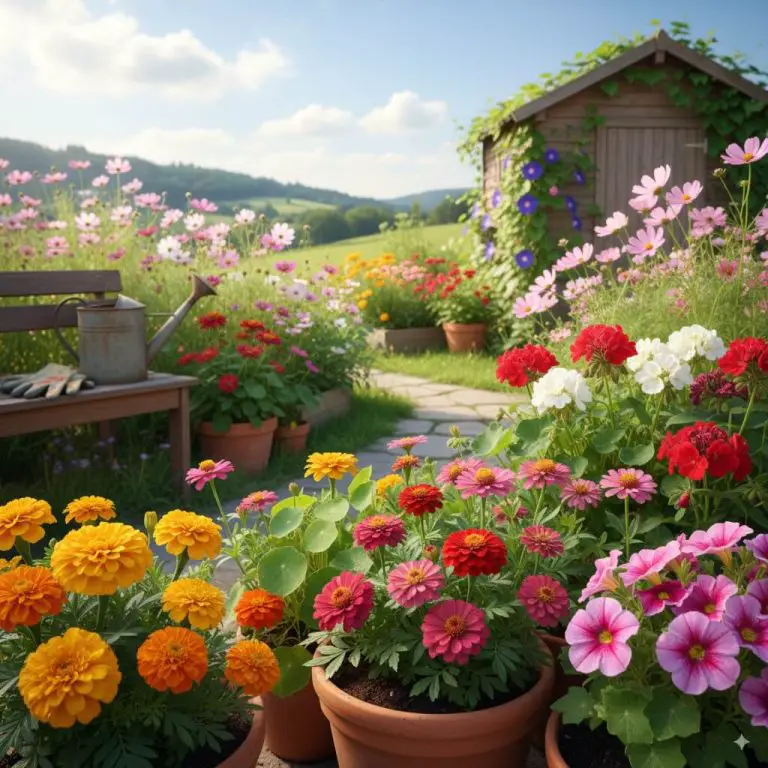Winter Flowering Container Plants – 10 Tough Beauties For A Vibrant
Does your patio look a little sad and grey once the frost arrives? It’s a common sight for many gardeners—the vibrant colors of summer and autumn fade, leaving behind empty pots and a sense of dormancy. It’s easy to think that the garden has to go to sleep for the season.
But what if I told you that your garden’s story doesn’t have to end in October? What if you could have pockets of brilliant color, delicate scents, and living beauty right on your doorstep, even on the coldest days? You absolutely can, and the secret is choosing the right winter flowering container plants.
I promise, this isn’t as complicated as it sounds. In this complete guide, we’ll walk through everything you need to know. We’ll explore the toughest, most beautiful plants that thrive in pots during winter, share a detailed care guide to ensure they flourish, and even show you how to design stunning arrangements that will make your neighbors jealous. Let’s banish the winter blues together!
What's On the Page
- 1 Why Bother with Winter Containers? The Surprising Benefits
- 2 Our Top 10 Winter Flowering Container Plants for Guaranteed Color
- 3 The Ultimate Winter Flowering Container Plants Care Guide
- 4 Designing Your Winter Masterpiece: A Step-by-Step Guide
- 5 Troubleshooting Common Problems with Winter Flowering Container Plants
- 6 Sustainable and Eco-Friendly Winter Gardening Practices
- 7 Frequently Asked Questions About Winter Flowering Container Plants
- 8 Your Winter Garden Awaits
Why Bother with Winter Containers? The Surprising Benefits
Before we dive into the “how-to,” let’s talk about the “why.” You might be thinking, “Is it really worth the effort?” As a gardener who has been doing this for years, I can tell you with certainty: yes, it is! The benefits of winter flowering container plants go far beyond just a pretty view.
- A Boost for Your Mental Health: Seeing life and color during the greyest months of the year is a powerful mood-lifter. Tending to your plants, even for just a few minutes, connects you to nature and provides a welcome dose of joy.
- Year-Round Curb Appeal: A beautifully planted container by your front door creates a warm, welcoming entrance for you and your guests. It shows that your home is cared for and loved, no matter the season.
- Vital Support for Wildlife: On milder winter days, some brave pollinators like winter-active bumblebees emerge in search of food. Plants like Winter Heather and Hellebores provide a crucial source of nectar when little else is available.
- Low-Maintenance Joy: Many winter bloomers are incredibly tough and require very little fuss once established. They are the unsung heroes of the garden, performing beautifully with minimal intervention.
Our Top 10 Winter Flowering Container Plants for Guaranteed Color
Ready for the fun part? Here are my tried-and-true favorites that have never let me down. These plants are selected for their resilience in pots, their long blooming season, and their sheer star power. Don’t worry—these flowers are perfect for beginners!

🌿 The Companion Planting & Gardening Book (eBook)
Bigger harvests, fewer pests — natural pairings & simple layouts. $2.40
Get – $2.40
🪴 The Pest-Free Indoor Garden (eBook)
DIY sprays & soil tips for bug-free houseplants. $1.99
Get – $1.991. Winter Pansies & Violas
These cheerful faces are the workhorses of the winter garden. Planted in autumn, they’ll often flower right through the mild spells of winter and then burst back into full glory in early spring. They come in every color imaginable.
2. Hellebores (Helleborus niger/orientalis)
Also known as the Christmas Rose or Lenten Rose, Hellebores are the definition of elegance. Their downward-facing, cup-shaped flowers are incredibly frost-resistant. A single, well-chosen Hellebore can be the stunning centerpiece of a large pot.
3. Winter-Flowering Heather (Erica carnea)
For long-lasting color and texture, nothing beats Winter Heather. Its tiny, bell-shaped flowers in shades of pink, white, and purple cover the plant for months. It’s also fantastic for pollinators and provides a great ‘filler’ in mixed containers.
4. Cyclamen (Hardy varieties)
Be sure to choose the hardy, outdoor varieties like Cyclamen coum or hederifolium. Their delicate, swept-back petals and beautifully patterned leaves add a touch of woodland magic. They prefer a sheltered spot out of the driving rain.
5. Skimmia japonica
Skimmia is a fantastic evergreen shrub for containers that offers year-round interest. In autumn, it develops tight clusters of red or white flower buds that remain all winter, finally opening into fragrant flowers in spring. Some female varieties also produce bright red berries!
6. Winter-Flowering Jasmine (Jasminum nudiflorum)
Need a bit of height or something to trail over the side of a pot? This is your plant. Its cheerful yellow, star-shaped flowers appear on bare green stems, bringing a welcome splash of sunshine to dreary days. It’s incredibly tough and easy to grow.
7. Camellia (Sasanqua or Japonica varieties)
For a true showstopper, a Camellia in a large pot is unbeatable. Early-flowering varieties can start blooming as early as December, producing exquisite, rose-like flowers. Remember, they need ericaceous (acidic) compost to thrive.
8. Snowdrops (Galanthus)
The quintessential sign that spring is on its way. Tucking a few snowdrop bulbs into the top layer of your containers in autumn is a wonderful surprise for late winter. They are small but pack a powerful emotional punch.
9. Crocus (Crocus chrysanthus/tommasinianus)
Like snowdrops, crocuses are bulbs that signal the end of winter. Their vibrant purple, yellow, and white chalices are a welcome sight. Plant them around the edges of your pots for a delightful pop of color.
10. Ornamental Cabbage & Kale
Okay, they don’t technically “flower,” but their frilly rosettes in shades of purple, cream, and green are just as beautiful! They are incredibly frost-hardy and provide amazing structure and color that lasts all winter long.
The Ultimate Winter Flowering Container Plants Care Guide
Knowing how to winter flowering container plants is mostly about getting the basics right from the start. Winter conditions present unique challenges, but with these best practices, your pots will thrive. This is your complete winter flowering container plants care guide.
Choose the Right Container
This is more important than you might think! Terracotta pots can absorb water, freeze, and crack. Opt for containers made from frost-proof materials like fiberglass, resin, wood, or thick, high-fired ceramic. Most importantly, ensure your pot has at least one large drainage hole. Good drainage is non-negotiable in winter.
The Perfect Potting Mix
Winter soil needs to be free-draining to prevent waterlogging, which leads to root rot. I recommend using a high-quality, peat-free potting mix and adding a few handfuls of horticultural grit or perlite. This creates air pockets and allows excess water to escape easily.
Watering Wisely in Winter
This is the number one challenge. Plants in containers can dry out from wind, but they are also at risk of becoming waterlogged from rain. The rule is simple: check before you water. Stick your finger an inch into the soil. If it feels dry, water gently. If it’s damp, leave it alone. Never let your pots sit in a saucer full of water.
To Feed or Not to Feed?
For most winter flowering plants, you don’t need to add fertilizer. They are slow-growing and have minimal nutritional needs during the cold months. The exception is winter pansies, which can benefit from a very dilute liquid feed on a mild day to encourage more flowers.
Location, Location, Location
Position your containers where they will get the most winter sunlight possible. A spot near a house wall can provide extra warmth and shelter from the harshest winds and driving rain. Grouping pots together can also create a warmer microclimate for them.
Designing Your Winter Masterpiece: A Step-by-Step Guide
Creating a beautiful container is like painting a picture. A popular and easy-to-remember method is “Thriller, Filler, Spiller.” Here’s how to adapt it for your winter display.
- Choose Your “Thriller”: This is your tall, eye-catching centerpiece. A small evergreen shrub like a Skimmia, a vibrant red-stemmed Dogwood (Cornus), or an elegant Hellebore works perfectly.
- Add Your “Fillers”: These are mid-sized plants that add mass and color around your thriller. Winter Heather, Cyclamen, and Ornamental Kale are fantastic fillers.
- Tuck in Your “Spillers”: These are plants that trail over the edge of the pot, softening the lines. Trailing Ivy is a classic choice, as is Winter-Flowering Jasmine if you let it cascade down.
Pro Tip: Don’t forget foliage! The silvery leaves of Senecio cineraria (Dusty Miller) or the deep purples and oranges of Heuchera provide stunning contrast and texture that lasts all season long.
Troubleshooting Common Problems with Winter Flowering Container Plants
Even with the best care, you might run into a few issues. Here’s a quick look at some common problems with winter flowering container plants and how to fix them.
- Soggy, Yellowing Plants: This is almost always due to poor drainage. Check that the drainage hole isn’t blocked. You may need to gently tip the pot and add more grit to the mix for next year. For now, move it to a sheltered spot out of the rain.
- Frost Damage: After a hard freeze, some leaves or flowers might look brown and mushy. Don’t panic! Wait for milder weather and then simply snip off the damaged parts. The plant itself is likely fine.
- Lack of Flowers: This could be due to not enough light or, in the case of pansies, a need for deadheading. Gently pinch off spent blooms to encourage new ones to form.
- Pests: Pests are less of a problem in winter, but slugs can still be an issue for Hellebores and Cyclamen. Use wildlife-friendly slug pellets or copper tape around the pot rim to deter them.
Sustainable and Eco-Friendly Winter Gardening Practices
Your garden can be beautiful and kind to the planet at the same time. Embracing sustainable winter flowering container plants practices is easy and rewarding.
- Go Peat-Free: Always choose peat-free compost. Peat bogs are vital carbon sinks and unique ecosystems, and using peat-free alternatives is one of the best things we can do as gardeners.
- Reuse and Repurpose: Clean and reuse your plastic pots season after season. Get creative with containers—old boots, buckets, or metal tubs can make unique, recycled planters (just be sure to drill drainage holes!).
- Collect Your Own Water: Install a water butt to collect rainwater. It’s free, better for your plants than tap water, and reduces your environmental footprint.
- Choose Native and Wildlife-Friendly Plants: Prioritize plants like Heather and Hellebores that provide food for early pollinators, contributing to a healthier ecosystem.
Frequently Asked Questions About Winter Flowering Container Plants
Can my summer container plants survive the winter?
Most annual summer plants like petunias and geraniums will not survive a frost. However, some perennials can be overwintered. You can move the pots into a greenhouse, a sheltered porch, or wrap them in horticultural fleece for protection.
How do I protect my container plants from a hard freeze?
For a sudden, deep freeze, you have a few options. Move the pots closer to the house wall for radiant heat. Group them together to create a warmer microclimate. For very tender plants, you can wrap the pot (not just the plant) in bubble wrap or old blankets to insulate the roots.
Do I need to deadhead my winter flowers?
Yes, especially for pansies and violas! Regularly removing the spent flowers tells the plant to produce more blooms instead of setting seed. For plants like Hellebores, you can leave the faded flowers on as they often remain attractive for a long time.
Your Winter Garden Awaits
See? Your garden doesn’t have to be a barren landscape from November to March. By choosing the right plants and giving them a little bit of thoughtful care, you can create a vibrant, life-affirming display that will carry you through the darkest days of the year.
The joy of stepping outside to see a determined pansy smiling back at you or the scent of a winter-flowering jasmine on the air is a truly special part of gardening. It’s a reminder that even in the quietest season, there is always beauty to be found.
So go on, grab your gloves and a bag of compost. A colorful, cheerful winter is just a few pots away!
- What Nutrients Do Plants Need – Your Essential Guide To Thriving - December 13, 2025
- Vinegar Mold Spray – Your Natural Garden Guardian Against Unwanted - December 12, 2025
- Organic Insecticidal Soap – Your Ultimate Guide To Eco-Friendly Pest - December 12, 2025



